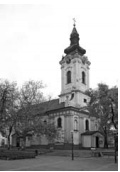Serbian Orthodox Church in Kikinda dedicated to St. Father Nikolai was built in the second half of the 18th century. It was built in baroque style. It is a one-nave building with a westward edge, which is somewhat wider than the base line and with a semicircular apse in the east. In architectural terms it is similar to most of the churches raised at that time in this area, which in the 19th century, after being killed during the revolution, were subsequently restored. The facade is decorative, and an elevated tower whose tiles mark the acrobatics in the form of a vase gives the church a monumental look. The side facades are with a series of semicircular apertures. Below all windows there is a decorative motif of lambrekene made in plastic.
What is of great importance to this temple is certainly preserved icons on the iconostasis and wall paintings that, due to their artistic value, are among the extraordinary works of Serbian art. During the eighties of the eighteenth century, extensive work began on painting the temple and painting the iconostasis. The iconostasis cartridge was recorded in 1773 but did not mention the name of the painter. It has long been thought that the author of the iconostasis and two wall compositions in the theater Teodor Ilić Češljar (1746-1793). This claim was corroborated by Cesljarev’s signature on one of the wall paintings created in 1790. In the opinion of Miroslav Timotijević that the Kikinda iconostasis Česljare’s work, it would have been his earliest iconostasis long before the iconostasis in Mokrin and before he, as a young artist, appears in Budim, where he works on painting the church of Sts. Dimitrija.For one such important work and in an important place Kikinda, which, in addition to Timisoara, turned into the most important and largest city of Upper Banat, an insufficiently known artist could not be engaged. Leposava Šelmić is of the same opinion and says that another painter gets this job, Jakov Orfelin (mid-18th century – 1803) thanks to the diplomas of the Vienna Academy of Arts and the occupation of uncle Zahari Orfelin.
The wooden part of the iconostasis in the handicraft carvings is the work of Markovic’s workshop in Novi Sad, dating back to 1770. It is clearly horizontally conceived and divided into three zones. In the first zone, there are icons in the hinges, doors, ceiling icons and several scenes above the doors. The blessings are the highest quality baroque work of rich color, while on most other compositions there are visible images, damages and retouches.
In the second zone there are scenes of holidays of original compositional solutions and air pallets, as well as a series of monumental figures of the apostles in heavy draperies. The third zone is performed in a distinctly Baroque manner, showing Crucifixes and figures of the prophet. All icons were made with oils on a wooden surface.
In parallel with the work on painting icons for icons, Orfelin has, in the opinion of Leposava Šelmić, made a wall composition on the vault above the sole with the play of Sv. three. This prosthetic composition also includes figures of the gospel with symbols. In the altar space, in the upper part of the niche, Jovan Zlatousti, and in the niche of proskomidije is a performance of Christ that bleeds in wounds.
Since the painting of the church took place in stages, Cesljar was only engaged in 1790 to build two monumental compositions on the walls in front of the singers: The secret dinner at the northern and Resurrection of Christ on the south wall. On the first composition he signed, and on the other he was recorded in 1790 and the name of the ktitor of the members of the prominent Kikinda family Popovic, Marko and his wife Ana. Both compositions were made in the manner of a late baroque style, a rock palette, and a secure drawing.
On the walls of the naos and priory there are four more compositions, created at the end of the XIX century, attributed to Ljubomir Aleksandrović (1828-1887), painter who received the first painting lessons in the workshops of Constantine Danilo and Nikola Aleksić.
The first major renovation of the church was made after the Revolution of 1848 when the church was burning. Whether there was a transfer of some painters’ ensembles, without expert examination, it is difficult to determine. It is certain that another intervention at the temple was carried out at the end of the XIX century by painting four wall compositions attributed to the painter Ljubomir Aleksandrović.
In the thirties of the twentieth century, a third renaissance followed, and in the sixties a restoration work was carried out in the temple. Two years ago, restoration and conservation of wall paintings in the temple started according to the conditions of this Institute.
SERBIAN ORTHODOX CHURCH OF ST. FATHER NIKOLAI IN KIKINDA


0 comments on “SERBIAN ORTHODOX CHURCH OF ST. FATHER NIKOLAI IN KIKINDA”